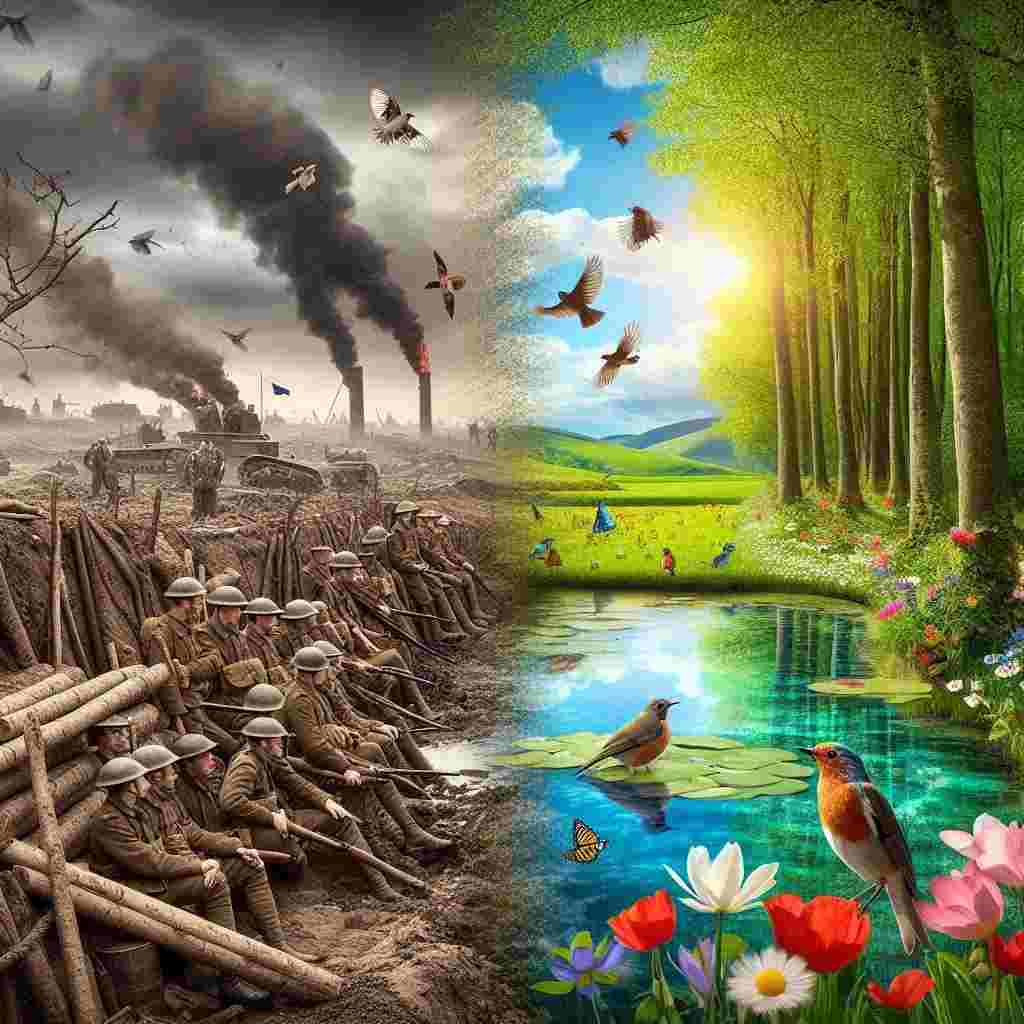There Will Come Soft Rains
Sara Teasdale
1884 to 1933

There will come soft rains and the smell of the ground,
And swallows circling with their shimmering sound;
And frogs in the pools singing at night,
And wild plum trees in tremulous white;
Robins will wear their feathery fire,
Whistling their whims on a low fence-wire;
And not one will know of the war, not one
Will care at last when it is done.
Not one would mind, neither bird nor tree,
If mankind perished utterly;
And Spring herself, when she woke at dawn
Would scarcely know that we were gone.
Sara Teasdale's There Will Come Soft Rains
Introduction
Sara Teasdale's poem "There Will Come Soft Rains" stands as a poignant reflection on the relationship between humanity and nature, juxtaposing the enduring cycles of the natural world with the transient nature of human existence and conflict. Published in 1920, in the aftermath of World War I, this twelve-line poem encapsulates themes of environmental indifference, the futility of human endeavors, and the stark contrast between the beauty of nature and the destructive capacity of mankind. Through its vivid imagery and haunting final message, Teasdale's work continues to resonate with readers, offering a profound meditation on our place within the grand tapestry of the natural world.
Historical Context and Thematic Resonance
To fully appreciate the depth of "There Will Come Soft Rains," one must consider the historical context in which it was written. The poem emerged in the wake of the First World War, a conflict that had shaken the foundations of Western civilization and left millions dead. This global catastrophe prompted a reevaluation of humanity's role in the world and our relationship with nature. Teasdale, like many of her contemporaries, grappled with the stark realization of human mortality and insignificance in the face of nature's eternal cycles.
The poem's title itself carries a dual meaning, evoking both the gentle return of spring rains and the ominous specter of nuclear fallout—a prescient allusion, given that the atomic age was still decades away. This duality sets the stage for the poem's exploration of nature's beauty and indifference, creating a tension that runs throughout the work.
Analysis of Form and Structure
Teasdale employs a carefully crafted structure to convey her message. The poem consists of six couplets, each with a rhyme scheme of AA BB CC, etc. This regular, melodic structure mirrors the cyclical nature of the seasons described within the poem. The use of iambic tetrameter in most lines creates a gentle, lilting rhythm that echoes the "soft rains" of the title, further reinforcing the sense of natural harmony.
The poem can be divided into two distinct parts: the first eight lines paint a vivid picture of nature's renewal, while the final four lines deliver the sobering message of humanity's insignificance. This structural division emphasizes the contrast between the enduring beauty of the natural world and the fleeting impact of human civilization.
Imagery and Sensory Detail
One of the poem's most striking features is its rich, sensory imagery. Teasdale employs a palette of visual, auditory, and olfactory details to immerse the reader in a vibrant natural scene. The "smell of the ground" evokes the earthy scent of petrichor, while the "swallows circling with their shimmering sound" creates a synesthetic blend of sight and sound. The "wild plum trees in tremulous white" offers a delicate visual image, their trembling blossoms suggesting both fragility and vitality.
The poet's use of personification further enlivens the natural world. Robins "wear their feathery fire" and whistle "their whims," imbuing the birds with a sense of agency and personality. This technique serves to heighten the contrast between the vivid, active natural world and the absent human presence.
The Turning Point: Human Absence
The poem's pivot occurs in the seventh and eighth lines, where Teasdale introduces the concept of war and, by extension, human conflict. The statement that "not one will know of the war, not one / Will care at last when it is done" serves as a harsh reminder of nature's indifference to human affairs. This indifference is not portrayed as malevolent, but rather as a simple fact of existence—the natural world continues its cycles, oblivious to the triumphs and tragedies of human history.
Environmental Commentary and the Anthropocene
While Teasdale could not have foreseen the full extent of humanity's impact on the environment, "There Will Come Soft Rains" resonates strongly with contemporary concerns about climate change and the Anthropocene. The poem's suggestion that nature would continue unabated "If mankind perished utterly" raises questions about the long-term effects of human activity on the planet.
In this light, the poem can be read as an early example of environmental literature, challenging anthropocentric views of the world and highlighting the resilience of nature in the face of human-induced changes. The final lines, describing Spring awakening "at dawn" barely noticing humanity's absence, serve as a powerful reminder of our species' relative insignificance in the grand scheme of natural history.
Intertextuality and Literary Influence
"There Will Come Soft Rains" has left an indelible mark on literature, perhaps most notably inspiring Ray Bradbury's 1950 short story of the same name. Bradbury's tale, set in a post-apocalyptic world where an automated house continues to function in the absence of its human inhabitants, expands on Teasdale's themes of human transience and nature's indifference.
The poem's influence extends beyond science fiction, resonating with environmental writers, war poets, and those exploring themes of human mortality and natural cycles. Its concise yet powerful message continues to be relevant in discussions of ecology, war, and the human condition.
The Power of Understatement
One of the most striking aspects of Teasdale's poem is its use of understatement to convey profound truths. The gentle, almost nonchalant tone with which the poem describes the potential extinction of humanity ("And Spring herself, when she woke at dawn / Would scarcely know that we were gone") belies the gravity of the subject matter. This understated approach serves to heighten the impact of the poem's message, allowing readers to confront uncomfortable truths about human mortality and insignificance without resorting to overt didacticism or melodrama.
Conclusion
Sara Teasdale's "There Will Come Soft Rains" stands as a masterpiece of early 20th-century poetry, its brevity belying its profound impact and lasting relevance. Through its skillful use of imagery, structure, and thematic complexity, the poem offers a meditation on the relationship between humanity and nature that continues to resonate with readers more than a century after its publication.
The poem's enduring power lies in its ability to evoke both the beauty of the natural world and the sobering reality of human transience. It challenges us to reconsider our place in the universe, suggesting that while our individual lives and even our entire civilization may be fleeting, the cycles of nature endure. In an age of increasing environmental awareness and existential questioning, Teasdale's work remains a poignant reminder of the delicate balance between human endeavors and the vast, indifferent natural world in which we exist.
As we continue to grapple with issues of war, environmental degradation, and our species' long-term impact on the planet, "There Will Come Soft Rains" offers a perspective that is both humbling and oddly comforting. It reminds us that while our actions may have far-reaching consequences, the Earth will continue to turn, the seasons will change, and life in some form will persist, with or without us. In this way, Teasdale's poem serves not only as a work of literary beauty but as a call to humility and a recognition of our place within the greater tapestry of existence.
This text was generated by AI and is for reference only. Learn more
Want to join the discussion? Reopen or create a unique username to comment. No personal details required!



Comments
No comments yet. Be the first to comment!